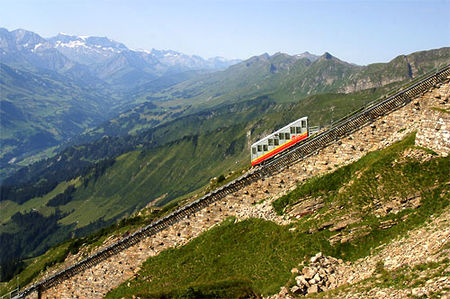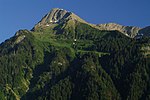Niesenbahn funicular

The Niesenbahn is a funicular railway above Lake Thun in the canton of Bern, Switzerland. It links a lower terminus, in the village of Mülenen at 693 m and adjacent to Mülenen station on the Lötschberg railway line, with an upper terminus at 2336 m near the summit of Niesen, a viewpoint above the lake and Bernese Oberland.The funicular is divided into two portions with a total length of 3.5 kilometers, an elevation difference of 1643 meters, and a maximum slope of 68%. Construction of the line commenced in 1906, and it opened in 1910.The service stairway for the Niesenbahn funicular is listed by Guinness Book of Records as the longest stairway, with 11,674 steps and a height of 1,669 m (5,476 ft). The stairs are usually employee-only, but there is a public run called "Niesenlauf" once a year. The line is owned and operated by the Niesenbahn AG.
Excerpt from the Wikipedia article Niesenbahn funicular (License: CC BY-SA 3.0, Authors, Images).Niesenbahn funicular
Heustrichstrasse,
Geographical coordinates (GPS) Address Nearby Places Show on map
Geographical coordinates (GPS)
| Latitude | Longitude |
|---|---|
| N 46.639356 ° | E 7.69021 ° |
Address
Heustrichstrasse 12
3711
Bern, Switzerland
Open on Google Maps









